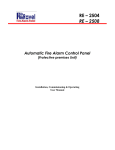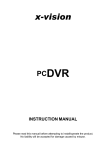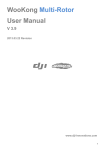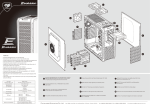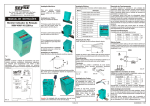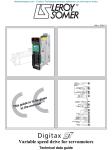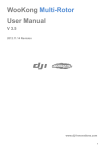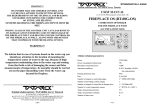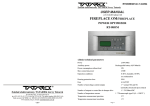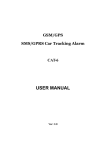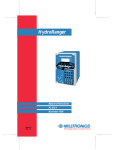Download Operating instructions Multiranger DS Series and Microranger DT
Transcript
Operating instructions Multiranger DS Series and Microranger DT Series Panel mounted Tachometers/ ratemeters counters/timers Phone: Fax: 44 (0) 1204-532544 44 (0) 1204-522285 www.compactinstruments.co.uk email: [email protected] Contents Multiranger Tachometers DS48 specification Factory adjustable parameters Output module Specification 0−10v output 0−20ma output 4−20ma output Serial Output RS232 Analogue input module 1 2 2 2 2 2 2 3 3 Measuring range and Function select controls & set up Sensors and Signal inputs Sensitivity Control Measurement mode selection Reset options Display resolution Scaling factor setting Input pulse divider Pulse Output Reset Process time 3 4 4 4 5 5 5 6 6 6 6 Output Modules Analogue output Serial output Analogue ouput setup 6 6 6 6 Input module 7 Speed trip module Specification Terminations Front controls Rear panel Preset level setting Procedure Relay Mode Count mode Reset Inhibit control Time out / motion stopped Multiranger numbering system 8 8 8 9 9 10 10 10 10 10 10 11 Microranger Tachometers DT48 specification Set up procedures Sensors and Signal inputs Measurement mode selection Reset options Pulse Output Reset Input Divider / Sensor Select options Microranger numbering system 12 13 14 14 14 15 15 16 16 17 DS Multiranger Tachometers 1 Specifications DS48 specification Speed modes Speed range Accuracy Resolution Display update time 0.001 to 99999 rpm (12Khz max using input divider) - 0.02% of reading ± 1 digit ±1 digit (0.001 RPM below 100RPM) 0.8secs or time between input pulses whichever is longer 0.1 secs if output module fitted Cycle time 0.01sec to 99,999secs Count mode 5 digits with overflow to 8 digits (autoranging) Accumulated time 0.01 - 99999secs Scaling factor × or ÷ by 0.001 to 99,999 (operates on all functions) Power supply options 1) Mains 110−240V AC +10%−15% (ext fuse ceramic 250mA A/S) 2) DC Version 10 to 36v DC 3) 24v AC Sensor supply 12V DC @50ma, and 5V DC @ 100ma Enclosure DIN 48 × 96 × 140mm Panel cut out 42.5 × 91.5mm Factory adjustable parameters (To Order) Internal scaling factor × or ÷ by 0.001 to 99,999 Update time 0.1 secs to 60secs Under range speed 3RPM to 0.1RPM Output module Specification 0−10v output Update time Output range Accuracy Full scale error Resolution Zero offset (max) Temperature Coefficient 0.1 secs or time between input pulses 0−9.99 Volts ±0.15% of span ±0.15% of span 2.5 mv 25 mV ±30ppm/° C 0−20ma output Update time Output range Accuracy Resolution Zero offset (max) Max load Temperature Coefficient 0.1 secs or time between input pulses 0−20ma ±0.3% of span 10 microamps 100 microamps 500 Ohms ±100ppm/° C 4−20ma output Update time Output range Accuracy Resolution zero offset (max) Max load 0.1 secs or time between input pulses 4−20ma ±0.3% of span 10 microamps 100 microamps 500 Ohms Ranges selectable on analogue output 0−999 0−9.99v 0−20ma 0−9990 0−9.99v 0−20ma 0−99900 0−9.99v 0−20ma 0−xxxxx 0−9.99v 0−20ma 2 4−20ma 4−20ma 4−20ma* 4−20ma *ex−works setting customer programmable Serial Output RS232 Update time Baud Rate Data Bits Stop bits Parity Output format End of line character Connection 0.1 secs or time between input pulses 9600 8 1 none Displayed value in Ascii characters MSD first including decimal point. Carriage return ( 13 decimal, 0D hexadecimal). RJ11 connector Analogue input module Full Scale input Accuracy Full scale error Nonlinearity Temperature Coefficient 9.99v ±0.15% of span ±0.15% of span ±0.15% of span ±100ppm Measuring range and Function select controls To access these remove the front bezel and display filter Analogue range select program push button ON 1 2 1 2 3 4 5 6 7 8 9 10 DIP Switches Scaling Factor input divider and voltage selection facilities These are located on the rear panel of the instument MADE IN UK 9 0 1 9 0 1 9 0 1 9 0 0 9 1 1 8 2 8 2 8 2 8 2 8 2 7 3 7 3 7 3 7 3 7 3 6 5 6 4 MSD 5 4 6 4 5 6 5 6 4 5 1 10 2 3 4 10 10 10 2 3 D.P. 4 1 LSD SCALING FACTOR 0 INPUT DIVIDER SENSITIVITY MAINS SELECT 120 240 Vac Vac 220 110 50/60Hz 10Watts max 1 2 3 4 5 +12V NC DC Versions TO BE FUSED EXTERNALLY L N +V 0V +5V 6 7 8 9 10 11 Time Prox OV Pulse Mag Pu Reset Output Note voltage selector switch not fitted on DC versions 3 Set up procedures Function select DIP switches (see diagram on previous page for the location of these switches) DIP SWITCHES (FRONT) 1 2 Reset options 3 4 Measure mode 5 Scale set 6 7 8 Display resolution 9 10 Sensor Select off on Reset Tacho/Rate Mult No decimal point Flash Count Hold Div NPN 1 decimal point PNP Cycle time 2 decimal points Magnetic and Pulse input Total plus Link 6 &10 3 decimal points Auto ranging Remove display bezel & filter to access switches Sensors and Signal inputs NPN/PNP Proximity sensors. Connect the sensor +ve wire to +12v(terminal 4), 0v wire to 0v (terminal 10), sensor output to Proximity input (terminal 8). Configure the unit to the appropriate sensor type using the front panel DIP switches 9 & 10 as shown above. Magnetic sensors . Connect the sensor between 0v( terminal 10) and Magnetic input (terminal 9). Configure the unit to magnetic input using the front panel DIP switches 9 & 10 as shown above. Namur 2-wire sensors Connect the sensor 0v wire to 0v(terminal 10) and the signal wire to proximity input (terminal 8).Configure the unit to NPN input using the front panel DIP switches 9 & 10 as shown above. Pulse inputs (2−30v DC) Connect the +ve to magnetic input (terminal 9) and 0v to 0v (terminal 10). Configure the unit to magnetic input using the front panel DIP switches 9 & 10 as shown above. Encoders Connect the +ve supply to 5v (terminal 5) or 12v (terminal 4) as required, output signal to magnetic input (terminal 9) and 0v to 0v (terminal 10). Configure the unit to magnetic input using the front panel DIP switches 9 & 10 as shown above. AC signal sources ( 2−30v Peak) Connect and configure as for magnetic sensors Sensitivity Control This sets the level above which the input needs to reach in order for the signal to be recognised. The noise rejection of the instrument also increases as this level is increased. Measurement mode selection RPM Set the front panel DIP switches 3 & 4 to Tacho/rate, the unit will then display the speed of the input pulses in RPM. Count Set the front panel DIP switches 3 & 4 to Count and set the Display resolution to Autoranging(see Display resolution below). The unit will now display a running total of the input pulses received since the power was applied or since the last reset. When the count value 4 exceeds 99,999 counts the unit will auto-range and count in 10’s . The decimal point will move to indicate the position of the thousands ( i.e. it can be read as the comma that separates thousands from the hundreds e.g. 264.12 = a count of 264,120). If the count again exceeds 999.99 it will again auto-range and count in 100’s. The maximum count is 99,999,999. Accumulated time / Count duration If during a count session “time” ( rear terminal 6) is connected to 0v (terminal 10) the unit will display the time elapsed since the count began. On removing this connection the count will again be displayed. Cycle Time/ Time interval Set the front DIP switches 3&4 to Cycle time and the display resolution to Auto ranging. The unit will now display the time between successive input pulses to a maximum resolution of 0.01 seconds. If the time exceeds 99.990 Secs the unit will auto-range and continue to display the time up to 999.99 secs. It will again autorange and display time up to 9999.9 secs but to a resolution of 0.1 seconds. At times greater than 9,999.9 seconds the unit will again auto-range enabling a maximum count value of 99,999 seconds to a resolution of 1 second. When used in conjunction with the scaling factor this mode can be used to display long process times but with a fast update ( see Process time page 6) Display resolution (rpm modes only) The resolution of the display can be set to either a fixed resolution of 0,1,2 or 3 decimal places or to be fully autoranging in which case the maximum number of decimal places possible at the current speed will be displayed. To select auto range mode set DIP switch 6 to on, in this case switches 7&8 will have no effect. To select a fixed number of decimal places set DIP switch 6 to off and select the number of decimal places required as per the above diagram. Note that when in fixed resolution mode if a resolution is chosen that is too great to fit the whole value in the 5 digit display the higher digits will be lost but the overall measurement resolution is not changed so the least significant digits will not be displayed to the full accuracy of the unit. Reset options These two DIP switches determine the operation of the unit in under-range and over- range conditions the alternatives are:1 Reset to zero if no pulses have been received for 20 seconds ( i.e. if the input speed is less than 3 rpm) DIP switch 1 should be set to on. If this is set then it overrides the action of DIP switch 2 2 Continue to measure below 3 RPM. DIP switches 1&2 off. In this case the unit will continue to measure speeds down to 0.001rpm. Note in this mode if the apparatus being measured stops then the unit will never go to zero but will continue to display the last reading. 3 Flash Display on under/over-range conditions DIP switch 2 on. In this case the display will flash when an input pulse has not be received for 20 seconds and the display holds the last reading until another pulse is received. It will also flash the display if the displayed value is greater than 99,999 or if displaying a fixed number of decimal places the value is larger than can be displayed with those number of decimal places. Scaling factor This function can be applied to all measurement modes and is set using the 5 rotary BCD switches labelled scaling factor on the rear panel and the upper rear slide switch. The scaling factor can be either a multiplication factor or a division factor. To set the Scaling factor first determine whether the value should be divided or multiplied by the factor and set the Front DIP switch 5 accordingly. Enter the scaling factor including any decimal places required into the 5 scaling factor switches. If the factor contains decimal places then set the rear upper slide switch to the number of decimal places required. Eg. for a scaling factor of 24.86 set the switches as shown 9 0 1 8 9 0 1 7 3 7 6 5 MSD 4 9 0 1 2 8 2 8 3 7 6 5 4 9 0 5 4 SCALING FACTOR 0 1 2 8 3 7 6 9 1 2 8 3 7 6 5 4 0 1 2 3 D.P. 2 3 6 5 4 LSD 5 The scaling factor resolution and the display resolution are completely independent of each other however the measurement resolution can not be increased by the scaling factor e.g. if the unit is in count mode and the scaling factor is set to multiply by 43 the for each count input the display will increment in steps of 43. The scaling function is purely a mathematical calculation on the measured value and hence has no adverse effect on update time etc. Input pulse divider This is the lower slide switch on the rear panel. It enables the input pulse rate to be divided by 1, 10, 102(100), 103(1,000) and 104(10,000). This can be used to measure pulse rates higher than the normal maximum input rate of 99,999rpm up to a maximum of 12Khz ( 5v square wave 1:1 mark space ratio). It can also be used at slower speeds to average or smooth erratic readings. If the divided input period is Greater than 0.8 seconds then the update time will become the input period thus enabling the update and hence the averaging effect to be increased. NOTE when the reset options (see above) are enabled these refer to the pulse rate after the input divider. Pulse Output A 5v TTL compatible output is available on terminal 7. This output is at the same rate as the incoming pulse rate no scaling is applied to it. It can be used to drive addition instruments that require a 5v pulse input. The maximum loading on this signal is 1K pull up to 5v or 100k pulldown to 0v. Reset A reset capability is available via terminal 11 on the rear panel. The unit can be reset momentarily connecting this terminal to 0v (terminal 10) . When the reset is connected to 0v the unit will stop and the display will continue to display the last reading. When Ov is removed from the reset. The Unit is only then reset internally with the measurement starting again from zero. Process time Long process times such as those of baking ovens can be measured and controlled with a fast update time by using the Time interval mode in conjunction with the scaling factor. This can be achieved by monitoring the speed of the conveyors drive motor. These pulses can be reduced in frequency by using the input divider until the measured value is of sufficient resolution. The displayed value can then be scaled so that the display indicates the actual process time. Using this method it is possible to measure process times of long durations (several minutes or even hours) and yet have an update of only a few seconds. Output Modules Analogue These are optional factory fitted modules that enable the measured value to be output in various preselected formats for further processing, recording or to be used for control purposes. The voltage and current outputs are available on rear terminal 6. The current/ voltage outputs have three fixed ranges and one customer programmable mode. In the fixed ranges the maximum output voltage/current corresponds to 999 in either the left hand three digits of the display, the middle three digits or the right hand three digits. In each case the other digits in the display have no effect on the output. The output is updated at the same rate as the display and between updates the output remains constant. If one of these is fitted then the Display update time is set at 0.1 seconds. Serial The RS232 output is via a RJ11 connector situated on the side of the instrument. This output continually transmits as ASCII characters the value in the display. The connections to RJ11 connector are pin 2 = Transmitted data, pin 5 = 0volts Only one of the voltage/current types may be fitted at once, the RS232 out may be fitted in conjunction with one of these or on its own. 6 Set up of analogue output module program push button Analogue range select ON ANALOGUE RANGE SELECTION 1 FRONT VIEW 1 2 2 RANGE 0 - 999 0 - 9990 0 - 99900 customer program REAR VIEW 1 2 3 4 5 6 7 8 9 10 11 ANALOGUE OUTPUT Preset ranges Select the speed range to be measured (0−999, 0−9990, 0−99,900) using the analogue range selection switches found behind the front panel as shown in the above diagram. Range 0−999 0−9990 0−99900 works setting DA1 0−9.99v 0−9.99v 0−9.99v DA2 0−20ma 0−20ma 0−20ma DA3 4−20ma 4−20ma 4−20ma* *ex- Customer program mode Apply power to the instrument Select customer program on the analogue range selection DIP switches Enter the maximum speed that the full scale analogue output will correspond to, via the 5 rotary BCD switches on the back panel any decimal place required can be set using the upper slide switch (see scaling factor page 5) Press the program push button once, the green LED next to the switch will flash. The unit is now programmed Set the rear BCD switches to the scaling factor required (if no scaling is required set to 00001) Note: The accumulated time mode is not available on units fitted with an analogue output. Input module This allows a voltage of 0−10v to be applied to the input of the unit which will then show a value of 0−9,999 on the display. This value may then be scaled as required using the rear scaling factor switches. Connect the Ov to terminal 10 and the positive input to terminal 6 Note The input divider switch must be set to divide by 10 position 7 Speed trip module This versatile Set point alarm is available with one or two independently presettable levels, which may be configured to trip on either under or over speed, the relays may be set to either energised or de-energised in either case. An inhibit timer for start up on under speed applications is incorporated as is a motion stopped detector. As well as speed measurements the unit will also work with all other measurement modes of the tachometer i.e. Count, cycle time and accumulated time. Specification Output Relay(s) Reponse Time Under speed time out Single pole changeover 2A non-inductive @240VAC or 30VDC Immediate when the displayed value changes to a value greater than the set value Equal to resolution of displayed value Output relays may be individually set to energise when the input speed is under or over the set speed Adjustable 1—9 Secs. or customer defined via external contact closure Detects motion stopped within 3 seconds if activated No of channels Enclosure Single or Dual 96 x96 x 136 mm Trip Resolution Trip Modes Start up inhibit delay Terminations Level 1 relay Level 2 relay Time out Inhibit Common 12 - Normally closed 13 - Common 14 - Normally open 15 - Normally closed 16 - common 17 - Normally open 18 - external control 19 - external control 20 - common 0 volts for external control For information on configuring the measurement/display portion of this unit refer to the DS48 instructions on page 1 8 Front controls Located behind front panel. S1 H O L D F L A S H T I N T C O U N T A U T O x . . 1 2 N D D P P P N DP SELECT DP1 DP2 0 0 1 0 0 1 1 1 P N P - S4 SELECTED NONE ONE TWO THREE LEVEL 1 0 S2 MODE DP1 DP2 4 5 6 DP2 DP1 MODE S3 INHIBIT DELAY SECS 1 SW1 2 3 S4 LEVEL 2 5 4 6 1 9 7 3 S5 8 2 0 MODE SW4/1+6 DISPLAY BELOW LEVEL 0 1 RELAY DE-ENERGISED RELAY ENERGISED 0 = EXT. CONTROL Rear panel MADE IN UK 9 0 1 9 0 1 9 0 1 9 0 0 9 1 1 8 2 8 2 8 2 8 2 8 2 7 3 7 3 7 3 7 3 7 3 6 6 4 5 4 6 4 6 5 5 MSD 6 4 0 1 10 10 2 D.P. 4 5 5 2 1 LSD SCALING FACTOR 3 3 10 4 10 INPUT DIVIDER SENSITIVITY MAINS SELECT 1 2 3 4 120 240 Vac 110 220 Vac 5 6 7 8 9 10 11 50/60Hz 10Watts max NC L +12V N TO BE FUSED +12V EXTERNALLY 0v (DC versions) LEVEL 1 LEVEL 2 N/C COM N/0 N/C COM N/0 12 13 14 15 16 17 +5V Time Prox OV Reset Pulse Mag Pu T I I N M H E I O B C U I O T T M 19 20 18 9 Preset level setting Procedure Enter the required value on the thumbwheel switches including any decimal places (e.g If the unit is required to trip at 231.32 RPM enter 23132) Select the number of decimal places required using the dip switches S4 (SW1&2 refer to level 1 setting, SW4&5 refer to Level 2 settings. Decimal Places None DP1 0 DP2 0 One 1 0 Two Three 0 1 1 1 E.G for the value 321.32 set the switchs to:-0 1 MODE DP1 DP2 Note: Always set the resolution of the thumbwheel setting to be the same as that of the Display. (The unit will still work if these do not match but there will be a loss of resolution) Relay Mode (S4 DIP switches SW1 /SW4) These switches determine whether the output relay is energised or de-energised when the display is above or below the set point. Count mode If the display unit is set to Count mode then the unit will act as a predetermined counter. The unit will trip as soon as the displayed count exceeds the selected value. NOTE;- there is no provision for auto resetting, the unit will continue counting after the set value has been reached. Reset A reset capability is available via terminal 11 on the rear panel. The unit can be reset by momentarily connecting this terminal to 0v (terminal 8) . When the reset is connected to 0v the unit will stop , the display will continue to display the last reading and the relays will remain in the same state. When Ov is removed from the reset. The Unit is only then reset internally with the measurement starting again from zero. Inhibit control This is normally used when the unit is being used to detect under speed. It allows the unit being monitored to reach operating speed without triggering an under speed alarm. Internal control this is set using the rotary switch S5 on the front panel. This can be set to select start up inhibit times from 1 to 9 seconds in 1 second increments External control -to activate this mode S5 must be set to zero. The unit will then wait for a momentary contact closure across terminal 19 & 20. Note unless external control is required do not set S5 to zero. Time out / motion stopped Normally the unit will not recognise that the input pulses have stopped until the Display drops to zero, this in turn depends on the reset options chosen for the display unit (with the normal 3 RPM limit this would be 20 seconds) In order to rapidly detect that a machine has stopped (e.g. in cases of mechanical failure) the unit can be set to time out after 3 seconds by connecting Timeout (terminal 18) to Common (terminal 20) 10 Multiranger numbering system DS CASE SIZE 48 = 48x96 96 = 96x96 72 = 72x72 BT= Bench PT = Portable SUPPLY 1 = 240/110 VAC 2 = 10 -36VDC 3 = 24VAC ANALOGUE OPTIONS 0 = None 1 = 0-10 VDC 2 = 0-20 ma 3 = 4-20 ma 4 = 0-10 VDC input XX X X X X X /XXX SPECIAL RS232 OUTPUT 0 = NONE 1 = FITTED TRIP OUTPUT 0 = NONE 1 = 1 Level 2 = 2 Level Note must be in 96 x96 CASE SEALS 0 = None 1 = IP55 Fitted 11 DT Microranger Tachometers 12 The Microranger series of DIN Digital tachometers are versatile instruments which can be used to measure rotational speed, cycle time, count and accumulated time. With the addition of the Input divider/ sensor select module the measured speed may be scaled to display the rate in engineering units and a wider range of sensor types can be used. Specifications DT48 specification Speed modes Speed range accuracy Resolution Display update time 0.001 to 99999 RPM (12,000,000 using input divider) - 0.02% of reading ± 1 digit ±1 digit (0.001 RPM below 100RPM) 0.8 secs or time between input pulses whichever is longer Cycle time Accumulated time Count mode Power supply options 0.01 sec to 99,999 secs 0.01 sec to 99,999 secs 5 digits with overflow to 8 digits (autoranging) 1) Mains 110−240V AC +10%−15% (ext fuse ceramic 250mA A/S) 2) DC Version 12V DC 12V DC @50ma, and 5V DC @ 100ma DIN 48 × 96 × 115mm (123mm including connectors) Panel cut out 42.5 × 91.5mm Sensor supply Enclosure size Scaling factors ×1 (standard) ×10, ×100 3 decade ÷1—999 (only available when input divider / sensor select option is fitted) Division factor REAR VIEW SENSOR 1 2 SELECTOR INPUT PULSE DIVIDER 3 MSD 4 9 0 LSD 0 9 1 9 1 8 2 8 2 8 7 3 7 3 7 6 5 4 6 5 4 0 1 2 3 6 5 4 MAINS SELECT 120 240 1 2 3 NC NC L N +12v 0v DC versions 4 5 6 7 +10V +5v +0V 8 9 10 11 12 SIG OUT TIME RESET 0V Rear panel Note sensor select switches and input pulse divider are only available when input divider/ sensor select option is fitted 13 Sensitivity control Input divider / sensor select options only 1 2 3 4 5 6 7 8 9 10 DIP Switches DIP switches ( located behind the front display filter) Set up procedures Function select DIP switches (see diagram above for the location of these switches) DIP SWITCHES (FRONT) 1 2 3 Measure Not used mode 4 5 Fixed multiplier 6 7 8 Display resolution 9 10 Reset options Off On Tacho/Rate Off rpm x 1 No decimal point Reset rpm x 10 1 decimal point Flash Cycle time rpm x 100 2 decimal points Hold Total plus Link 9 &11 3 decimal points Count Auto ranging Factory default settings Sensors and Signal inputs NPN Proximity sensors. Connect the sensor +ve wire to +10v (terminal 6), 0v wire to 0v (terminal 7), sensor output to Signal input (terminal 8). Namur 2-wire sensors Connect the sensor 0v wire to 0v(terminal 7) and the signal wire to Signal input (terminal 8). Measurement mode selection RPM Set the front panel DIP switches 1 & 2 to Tacho/rate, the unit will then display the speed of the input pulses in RPM. 14 Count Set the front panel DIP switches 1 & 2 to Count and set the Display resolution to Autoranging (see Display resolution below). The unit will now display a running total of the input pulses received since the power was applied or since the last reset. When the count value exceeds 99,999 counts the unit will auto-range and count in 10’s. The decimal point will move to indicate the position of the thousands (i.e. it can be read as the comma that separates thousands from the hundreds in a normal written number,e.g. 345,19 = a count of 345,190). If the count again exceeds 999.99 it will again auto- range and count in 100’s. The maximum count is 99,999,999. Accumulated time If during a count session “time” ( rear terminal 9) is connected to 0v (terminal 11) the unit will display the time elapsed since the count began. On removing this connection the count will again be displayed. Cycle Time Set the front DIP switches 1&2 to Cycle time and the display resolution to Auto ranging. The unit will now display the time between successive input pulses to a maximum resolution of 0.01 seconds. If the time exceeds 99.990 Secs the unit will auto-range and continue to display the time up to 999.99 secs It will again autorange and display time up to 9999.9 secs but to a resolution of 0.1 seconds. At times greater than 9,999.9 seconds the unit will again auto-range enabling a maximum count value of 99,999 seconds to a resolution of 1 second. Display resolution (rpm modes only) The resolution of the display can be set to either a fixed resolution of 0,1,2 or 3 decimal places or to be fully autoranging in which case the maximum number of decimal places possible at the current speed will be displayed. To select auto range mode set DIP switch 6 to on, in this case switches 7&8 will have no effect. To select a fixed number of decimal places set DIP switch 6 to off and select the number of decimal places required as per the above diagram. Note that when in fixed resolution mode if a resolution is chosen that is too great to fit the whole value in the 5 digit display the higher digits will be lost but the overall measurement resolution is not changed so the least significant digits will not be displayed to the full accuracy of the unit. Scaling Three fixed ratios can be applied to the measured value ×1, ×10, ×100 (rpm modes only) these are selected using DIP switches 4&5 as shown in the above diagram. This feature is normally used in conjunction with the input divider option ( see below) Reset options The two DIP switches 9&10 determine the operation of the unit in under-range and over- range conditions the alternatives are:Reset to zero if no pulses have been received for 20 seconds ( i.e. if the input speed is less than 3 rpm) DIP switch 9 should be set to on. If this is set then it overrides the action of DIP switch 10 (over-range enable) Continue to measure below 3 RPM. DIP switches 9&10 off. In this case the unit will continue to measure speeds down to 0.001 rpm. Note in this mode if the apparatus being measured stops then the unit will never go to zero but will continue to display the last reading. Flash Display on under/over-range conditions DIP switch 10 on. In this case the display will flash when an input pulse has not be received for 20 seconds and the display holds the last reading until another pulse is received. It will also flash the display if the displayed value is greater than 99,999 or if displaying a fixed number of decimal places the value is larger than can be displayed with those number of decimal places. Pulse Output A 5v TTL compatible output is available on terminal 10. This output is at the same rate as the incoming pulse rate no scaling is applied to it. It can be used to drive addition instruments that require a 5v pulse input. The maximum loading on this signal is 1K pull up to 5v or 100k pulldown to 0v. 15 Reset A reset capability is available via terminal 12 on the rear panel. The unit can be reset by momentarily connecting this terminal to 0v (terminal 11) . When the reset is connected to 0v the unit will stop and the display will continue to display the last reading. When Ov is removed from the reset the Unit will then reset internally with the measurement starting again from zero Input Divider / Sensor Select options If this option is fitted the following extra features are available Sensor selection SENSOR NPN (PROXIMITY) SWITCHES Factory Default setting PNP (PROXIMITY) OPTICAL ENCODER MAGNETIC 2-WIRE NAMUR NPN/PNP Proximity sensors. Connect the sensor +ve wire to +10v (terminal 6), 0v wire to 0v (terminal 7), sensor output to signal input (terminal 8). Configure the unit to the appropriate sensor type using the rear panel DIP switches 1—4 as shown above. Magnetic sensors . Connect the sensor between 0v( terminal 7) and Signal input (terminal 8). Configure the unit to magnetic input using the rear panel DIP switches 1—4 as shown above. Namur 2-wire sensors Connect the sensor 0v wire to 0v(terminal 7) and the signal wire to signal input (terminal 8).Configure the unit to NPN input using the rear panel DIP switches 1—4 as shown above. Pulse inputs (2−30v DC) Connect the +ve to magnetic input (terminal 8) and 0v to 0v (terminal 7). Configure the unit to magnetic input using the rear panel DIP switches 1—4 as shown above. Encoders Connect the +ve supply to 5v (terminal 5) or 12v (terminal 6) as required, output signal to Sensor input (terminal 8) and 0v to 0v (terminal 7). Configure the unit to magnetic input using the rear panel DIP switches 1—4 as shown above. AC signal sources ( 2−30v Peak) Connect and configure as for magnetic sensors Sensitivity Control This is situated behind the front panel sets the level above which the input needs to reach in order for the signal to be recognised. The noise rejection of the instrument also increases as this level is increased. Input Scaling A scaling factor may be applied to the measured speed in two ways 1. The input signal may be divided by a 1—999 using the 3 rotary switches on the rear panel. This may be used on all measurement modes. NOTE as this divides the input signal before it is applied to the measurement system tthere could be a large increase in update time at slow input rates with large division factors. 2 Multiplication factors ×1,×10,×100 can be selected using the front DIP switches 4&5 and can be used in conjunction with the rear division factor to give a range of scaling factors from ×100 to ÷ 999. This is can only be used on rpm modes. 3 Input pulse divider RPM - where more than one pulse per revolution is being used via a sensor the input divider should be set to the number of pulses per revolution. 16 Microranger numbering system DT CASE STYLE XX X X X /XXX SPECIAL 48=48×96 PANEL MOUNTED SUPPLY 1= 240/110 VAC 2=12VDC SEALS 0= NONE 1= IP55 FITTED INPUT DIVIDER/SENSOR SELECT OPTION 0= NONE 1= FITTED 17 ©Compact Instruments Ltd February 2003 Document No: 13989/4.3 18




















